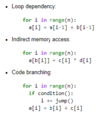Linear Algebra with NumPy Primer Flashcards
(52 cards)
What does this mean?

the set of all real-valued matrices with n rows and d columns
What is this called? What does it mean?
1(x)
- binary indicator function,
- returns 1 if x is a true boolean and 0 otherwise
What does this mean?

the set of all real-valued n-dimensional vectors
What does this mean?

the set of real numbers
What is this?

- A pair of input vector and output scalar
- The superscript indicates the index of this pair, not the exponent. In other words, x(5) is the input vector at index 5, not x raised to the power of 5.
What is this?
|C|
- Determinant if C is a matrix
- Cardinality (number of member elements) if C is a set.
What’s a column vector?
Each entry occupies one row.
What’s this?

One use: denotes the i-th entry of a column vector
What does this mean?

Row vector. Each entry covers 1 column
For matrix A, what is

denotes the i-th row of A
For matrix A, what is

denotes the i-th column of A
What can dot product be applied to? What’s the formula?
Two vectors of same dimensions

What’s the inner product?
Same as dot product
- What can outer product be applied to?
- What does it result in?
- What’s the formula?
- Vectors (can have different number of elements)

What’s another way to express a dot product for two column vectors x and y?

What’s this for two vectors x and y?

The outer product
What’s a matrix-vector product?

- What are the properties of matrix multiplication? (2)
- What properties does it not have? (1)
Matrix multiplication is:
- associative, (AB)C=A(BC)
- distributive, A(B+C)=AB+AC
Is not:
- commutative, AB≠BA
What’s a property of transposes?

What’s the Hadamard product?
elementwise matrix multiplication
What does this mean?

A standard basis vector - ith entry is 1 and the other entries are all 0
What does this denote?

Identity matrix of nxn size
What’s the point of a basis vector?
By multiplying a basis vector with a vector x∈Rn, we obtain the single entry xi
Describe the idea of one-hot encoding
- In each row of the resulting one-hot-encoded matrix:
- In each row of the original vector, find the value
- This value will serve as the column index of the “1” entry in the same row in the corresponding matrix.
- The remaining values in that row are 0
















